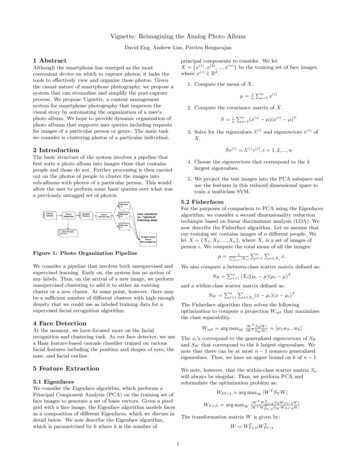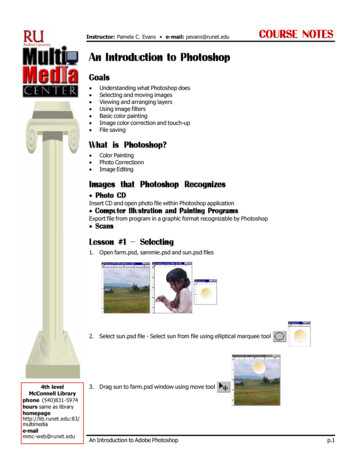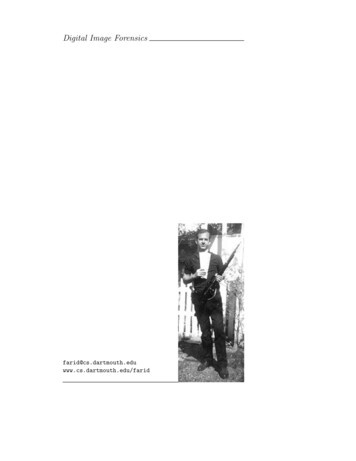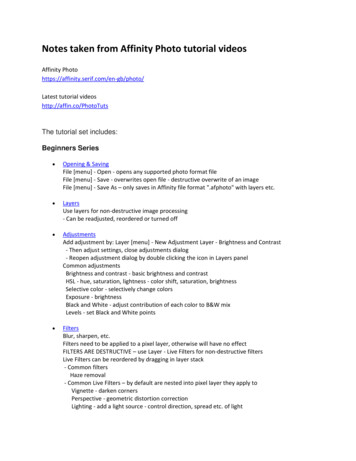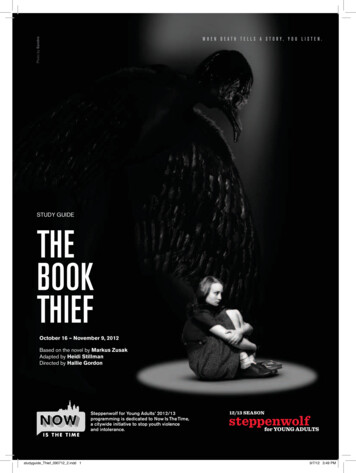
Transcription
Photo by SandroW h e n D e ath te l l s a sto ry, yo u l i ste n.Study GuidethebookthiefOctober 16 – November 9, 2012Based on the novel by Markus ZusakAdapted by Heidi StillmanDirected by Hallie GordonSteppenwolf for Young Adults’ 2012/13programming is dedicated to Now Is The Time,a citywide initiative to stop youth violenceand intolerance.studyguide Thief 090712 2.indd 112/13 SEASONfor YOUNG ADULTS9/7/12 3:49 PM
Book thief study guideWe were lucky to work in partnership with the Chicago Public Library in creating contentfor this guide. Please use the activities, questions for the classroom, designer notebookand cast photos we have provided in complement to the rich material provided in theOne Book, One Chicago guide.index:PHotographer Joe l MoormanDear Teachers:Thank you for joiningSteppenwolf for YoungAdults’ 2012/13 seasonas we dedicate ourprogramming to NowIs The Time, a citywidecall to action to stopyouth violence andintolerance.We are engaging with the ChicagoPublic Library, Facing History andOurselves and other theaters andcultural organizations for a season-longpartnership against youth violenceand intolerance.In recent years, violence towards youthhas become overwhelming. As theaterartists working in schools we see theeffects violence can have on youth.As teachers working in the classroomevery day, you are aware of thechallenges of teaching students whomay be scared to play outside, scaredto travel to school, scared becausethey face torment at school frombullying. We have a unique opportunityto inspire young people to makepositive change in their communitiesand give voice to this epidemic.In collaboration with the ChicagoPublic Library’s One Book, OneChicago, Markus Zusak’s TheBook Thief looks at the terriblecost of violence, bearing witness toour compassion and complicity, andempowering each of us to examine ourown unique ability to effect change inour communities.We hope you and your studentswill be inspired in your study ofThe Book Thief to contribute contentabout making positive change in ourcommunity to the Now Is The Timewebsite, nowisthetimechicago.org.We look forward to welcoming you toSteppenwolf and to joining togetherto inspire students to take action.Now Is The Time.–Hallie, Megan & LaurenArtistic and Educational DirectorHallie GordonEducation ManagerMegan ShuchmanEducation AssistantLauren Sivakreference:Welcome Letter2The Book ThiefSynopsis and Characters48Young Adult Council13Profile of a Set Designer1416For Further Reading21Acknowledgements22The Scene23Megan ShuchmanEducation Managermshuchman@steppenwolf.org312-654-56372. Interview with Zuzak, and adaptorof the play, Heidi Stillman—OBOC guide, p. 43. Timeline for historical context inWorld War II Germany—OBOC guide, p. 20Classroom ActivityRepresentation of DeathHallie GordonArtistic and Educational Directorhgordon@steppenwolf.org312-654-56071. Brief Biography of The Book Thiefauthor, Markus Zusak—OBOC guide, p. 2Classroom ActivityThe Power of WordsSteppenwolf for Young AdultsStaffReference the following sections from the OneBook, One Chicago guide for further information:4. Death Personified: A List of Fictionsin which Death is the ‘star’—OBOC guide, p. 305. Now Is The Time Information—OBOC guide, p. 38AccessibilityAudio-Described Performance and TouchTour, with Young Adult Council Scene eventto follow Saturday, October 27 at 3pmOpen-Captioned PerformanceSunday, October 28 at 3pmAmerican Sign Language-InterpretedPerformanceSunday, November 4 at 3pmSTUDY GUIDE Curated byMegan ShuchmanArticles byAnkita Kumar-Ratta, Megan Shuchman,Lauren Sivak and Safiya NygaardEdited byHallie GordonLauren SivakEducation uide Thief 090712 2.indd 2-39/7/12 3:49 PM
The Book Thief SynopsisThe Book Thief SynopsisSynopsis forThe Book ThiefImages from Trudy White, Illustrator for novelACT ONEHim, who is Death and the narrator of our story, introducesus to Liesel Meminger, a young girl who has stolenThe Gravedigger’s Handbook during the funeral ofher young brother. Liesel is orphaned when her father istaken away because of his political beliefs and her motheris too poor to care for her. She arrives at Himmel Street inthe small town of Molching at the beginning of World WarII to live with her new foster parents, Rosa Hubermann, alaundress, and Hans Hubermann, an accordion player andpainter by trade. The Nazi Party’s influence is oppressive inthe small town of Molching and it is impossible for Hans tofind work because he is not a member of the Nazi Party.Hans that she has a stolen book, but does not know howto read. Liesel and Hans, a poor reader himself, strugglenight after night through the book, slowly learning to readtogether. One night, Hans’ and Rosa’s son, Hans Jr.,pays a visit, chastising Hans for not joining the Nazi Partyand berating his father for not recognizing the power theFührer (Adolf Hitler) holds. Later, at a Nazi burning ofbooks considered to be ‘un-German,’ Liesel rescues TheShoulder Shrug from the fire. The mayor’s wife, IlsaHermann, sees her but says nothing. Afterwards, whenLiesel calls at the mayor’s home to pick up and drop offlaundry, Ilsa invites her inside to read in her extensive library,sharing her books and memories of her son, who died duringthe World War I. Hans procures a copy of Hitler’s MeinKampf from the local party office, and uses the book tohide a key to send to Max. Max is a Jew currently hiding fromthe Nazis and the son of Han’s best friend, who also diedin World War I. Thanks to the key Hans provides, he arrivesat the Hubermann’s home seeking a safe place to stay. Maxlives for several months in the Hubermann basement, duringwhich time he and Liesel grow to be close friends, bothplagued by nightmares of loved ones lost.Consumed with the grief at being taken from her family,Liesel is comforted by gentle Hans, whom she calls Papa,and a neighborhood friend, Rudy Steiner, who dreams ofbeing an Olympic runner like Jesse Owens. Rudy developsa crush on Liesel, challenging her to a race and wageringa kiss if he wins. He loses, but vows that one day, Lieselwill be “dying to kiss [him].” One night, after having anothernightmare about her brother’s death, Liesel confesses to4studyguide Thief 090712 2.indd 4-559/7/12 3:49 PM
The Book Thief SynopsisMeanwhile, Rosa’s customers are disappearing day byday, as no one has the money for laundry services. WhenIlsa can no longer use Rosa Hubermann as her laundress,Liesel, aware of how badly the Hubermanns need the money,becomes frightened and angry, railing against Ilsa andattacking her for still grieving her son’s death when thereis so much new despair around them. When she returnshome, Max shows Liesel how he ‘boxes with Hitler’ in hismind in order to keep from feeling consumed by his angerand devastation. When Rudy and Tommy, Rudy’s friend,are constantly bullied by Deutscher, the head of Molching’sHitler Youth, Rudy and Liesel take out their aggression bystealing a book from the mayor’s home. With this theft, Lieselofficially earns her title,“Book Thief.”ACT TWOHim reads aloud from his own diary, comparing war to atyrannical boss, never saying thank you and always askingfor more. On Liesel’s birthday, knowing of her love forreading, although Max cannot give her a real book, hetransforms Mein Kampf into his own book by painting overthe pages. One day, Liesel is out playing soccer with herfriends and hears news that the Nazis are searching housesfor Jews, and fakes an ankle injury as excuse to get homeand alert Hans and hide Max. A few days later, Rudy andLiesel find that Ilsa has tempted them with a book wedgedin her window: a dictionary, which they promptly steal. Then,during an air raid in which everyone is gathered together in abasement shelter, Liesel reads aloud from one of her booksto comfort the townspeople while Max takes the opportunityto come from hiding and steal a glance at the sky.6studyguide Thief 090712 2.indd 6-7Book thief charactersLater, when a procession of Jews is marched through townon their way to a concentration camp, Hans impulsivelyoffers a piece of bread to a starving Jewish man. He andthe man are beaten, and Hans must then get rid of Max asthe Nazis will surely suspect he is a sympathizer and searchhis home as a result of his act of kindness. Sometime afterMax’s departure, Liesel spots him in another procession ofJews being marched to a camp. Overcome by seeing herfriend, Liesel throws herself on Max, prompting a beatingfrom a Nazi soldier. After the beating, Liesel finds herself inIlsa’s library, where she destroys book upon book, worriedthe words will fill her with a false sense of hope she nolonger wants to have. When Ilsa catches her, instead ofpunishing Liesel, she gives her the gift of a journal, so shemight write her own story. Liesel retreats to her basementand begins to write the story of The Book Thief. As shewrites, Himmel Street is bombed. Rosa dies. Hans dies.Even Rudy dies. When Him comes to call on Molching topick up the souls of Himmel Street, he sees Liesel’s journalthat she has abandoned on the ground, and picks it up. Ilsatakes Liesel into her home to live with her. After the warends, Max appears, having survived the concentration camp,and together – as our narrator, Him, tells us — Liesel livesa good, long life. When Liesel’s time has come, years later,and Him comes to meet her, they exit the play together, handin hand.Him (our narrator, Death)is the sympathetic narrator of Liesel’sstory. Death’s duty is to carry the soulsof the dead away.HANS HUBERMANNPlayed by Mark UlrichLIESEL MEMINGERPlayed by Rae GrayROSA HUBERMANNPlayed by Amy J. Carleis Liesel’s foster father. Once a reluctantsoldier during World War I, he is a housepainter and accordionist. He teachesLiesel to read.is the book thief. She is nine years old atthe beginning of the story, when after thedeath of her brother she is taken in bythe Hubermann family.is Liesel’s foster mother. She washesand irons clothing for the wealthy peopleof Molching.Ilsa HERMANNPlayed by Nicole WiesnerMAX VANDENBURGPlayed by Patrick AndrewsRUDY STEINERPlayed by Clancy McCartneyis the wife of the Mayor of Molching.Her son, Johannes Hermann, was killedin World War I and she mourns hisdeath with her silence. She invites Lieselinto her library to read her books andseek refuge from the war and violencesurrounding her.is a young Jewish man who changesthe Hubermanns’ lives.is Liesel’s neighbor and eventual bestfriend. He is one of six children and isobsessed with American track athleteJesse Owens.For more character information, visit p.26-27 of the OBOC guide.79/7/12 3:50 PM
classroom activity: The Power of WordsThe Powerof WordsActivitytime total:45 min.20 minutes ofdiscussion andfree writing15 minutesof studentpresentation10 minutesof classdiscussionto followHIM: “You humans don’tneed a boxing ring toinflict injury, did youknow that? You cancommit violence withwords. And inspireviolence with words.You do that quite a lot.”LIESEL MEMINGER: “Words!Without you, therewouldn’t be any of this.Without words theFührer is nothing! Whatgood are the words?”Throughout Liesel’s journey in The Book Thief, she learns howwords hold a remarkable power to compel people to commitacts of cruelty as well as beauty. At the start of the play, Liesel isilliterate. Learning to read brings Liesel closer to understandingwhy and how Hitler has achieved power through his words. Lieselbegins to understand the manipulative power of words, and strivesto master the art of writing in hopes of making the words “right.”In this activity, we will work to understand the power effectivewords can have on inciting people to action, with both positive andnegative results.studyguide Thief 090712 2.indd 8-9Speech 1: Adolf HitlerAdolf Hitler:The following is an excerpt from the novel, The Book Thiefin which Max, a young Jewish man in hiding, imagines thathe is in a boxing ring, about to challenge Hitler to a match.When Max wins the fight, he envisions Hitler turning to thecrowd to warn them about the threat of the Jews. Thoughfictional, this speech was inspired by Adolf Hitler’s speech“The Jewish Question,” which he presented to the Reichstag(Parliament) on January 30, 1939, the sixth anniversary of hisrise to power.My fellow Germans. You can see that what we face issomething far more sinister and powerful than we everimagined. As we speak, he [Jews] is plotting his way intoyour neighborhood. He’s moving in next door, and he’sabout to take you over. He will soon own you, until it is hewho stands not at the counter of your grocery shop, but sitsin the back, smoking his pipe. Before you know it, you’ll beworking for him at minimum wage while he can hardly walkfor the weight in his pockets. Will you simply stand thereand let him do this? Or, will you climb up into this ring withme? For I cannot stand up here alone and fight him.Speech 2: Eleanor RooseveltELEANOR ROOSEVELT:On February 20, 1946, Eleanor Roosevelt delivered aspeech at the Opening Campaign Rally of the Women’sDivision of the United Jewish Appeal of Greater New York.The wife of President Franklin D. Roosevelt, Eleanor wasknown to be one of the most outspoken women in the WhiteHouse. She was a delegate to the United Nations GeneralAssembly and became the chair of the United NationsHuman Rights Commission. As part of this commission, shehelped write the Universal Declaration of Human Rights.It is a mistake to think that the displaced persons camps inGermany are any worse than the displaced persons campsin other places, or that the standards of food are worse thanthose that they have in the other countries. In many cases,the condition is made worse in the other countries becauseof the fact that, for a long period, they were under Nazioccupation. Therefore, their strength has been sapped overa longer period.After World War II ended, Eleanor visited a concentrationcamp at Zeilsheim, Germany and met a few of the Jewsliving there who had survived the camp. Eleanor struggledto understand the perseverance of the survivors of theHolocaust versus the passivity of the rest of the world.Activity:8Step 1: In small groups or individually, have students read the following excerpts:I have the feeling that we let our consciences realize toolate the need of standing up against something that weknew was wrong. We have therefore had to avenge it–butwe did nothing to prevent it. I hope that in the future, we aregoing to remember that there can be no compromise at anypoint with the things that we know are wrong. We shouldremember that in connection with all the things that we dohere, or in connection with anything at all in the world.We cannot live in an island of prosperity in a sea of humanmisery. It just can’t be done.I think the most important thing for us to realize is the greatresponsibility that lies upon our shoulders and the factthat we must give something beyond what we have evergiven before in the world—something that is no longer forourselves at all, but for humanity as a whole.99/7/12 3:50 PM
classroom activity: The power of the wordsSTEP 2: Have each student underline 10 words in eachexcerpt that stand out. These should be words that helpto effectively communicate what the speaker is trying tosay. Once the students have chosen their words, helpthem evaluate: How do the underlined words make you feel? What do theyevoke for you? What emotions do the words spark? Are there words you underlined in both the speeches byAdolf Hitler and Eleanor Roosevelt? If so, which words?How are the words used similarly in each speech? Differently?STEP 3: Provide a definition of propaganda to yourstudents, as in:Propaganda is a form of communication which aims to influence the attitude of agroup of people toward a specific cause or position. Propaganda presents factsselectively and uses loaded messages to produce an emotional, rather thanrational response to the information presented. Although often times propagandais regarded as a tool that propels negativity, it does not have to be negative.It can be used to promote ideas that result in a positive change or action.classroom activity: The Power of WordsSTEP 4: At Steppenwolf, we are presenting The Book Thiefas part of a season-long initiative to inspire positive actionin our community and to spark a citywide conversationaround youth violence and intolerance. The idea behind thisinitiative is to find ways we can make personal connectionsin our lives to changes we wish to see in our communities.With that and Eleanor Roosevelt’s speech in mind, havestudents write a speech that calls to action members oftheir community around the issue of youth violence. Thespeech should incite fellow citizens to speak up or actout against violence and intolerance. Have students thinkabout the following questions as they write: What power do words alone possess? How will your wordsalone inspire your audience to make a change? What aspects of your speech do you most hope people willremember? What do you want your audience to take away fromyour speech?Given this definition, have students answer: Are there elements of Hitler and Roosevelt’s speeches that fitthis definition? Why or why not? What are the elements of each speech from above that canbe considered propaganda?10studyguide Thief 090712 2.indd 10-11119/7/12 3:50 PM
classroom activity: The power of the wordsclassroom activity: writing exerciseQuestions for the Classroom:1. What does it mean to ‘commit violence using words?’2. How can we use our words to effect change positively?3. How can we use our words to actively respond to youth violence?Extra Writing Space:PHotographer Joe l MoormanSTEP 5: Choose a few students to present their speechesto the class. Post transcripts from these speeches (orvideos of your students reciting these speeches) on ourNow Is The Time site, www.nowisthetimechicago.orgso that other students can be inspired by the power oflanguage and by seeing fellow students use the power ofwords to influence change.Young Adult CouncilThe Young Adult Council is a unique program for passionate and motivatedhigh school students who wish to learn the inner-workings of professionaltheater from the most celebrated artists in the city. In addition to face timewith these leading professionals, Council members attend the best plays inChicago, learn how to analyze and speak about these plays and lead eventsfor their peers around Steppenwolf productions in hopes of inspiring a newgeneration of theatre enthusiasts and practitioners.Applications are available on March 1, 2013.Like the Steppenwolf Young AdultCouncil on Facebook12studyguide Thief 090712 2.indd 12-13Or visit steppenwolf.org/youngadultcouncilfor more information.Foundation support is provided byThe Siragusa Foundation.139/7/12 3:50 PM
designer NotebookDesignernotebook“A set designer's work is part of acollaborative process; the set, thelighting, costumes and sounds,coupled with the actions of the cast,make up the whole picture.”–The Book Thief set designer, Lizzie BrackenCorbin Little: What was the toughest part ofdesigning the set for The Book Thief?Lizzie Bracken: The play is like a big puzzle. How dowe capture a story that ranges over a dozen locations withinthe confines of our stage and our budget? The tricky partwas finding a design that maintained the general aestheticwhile also providing the flexibility to represent all of thelocations that the story demanded.Inspirational artwork, Velocità d'automobile by Italian painterGiacomo Balla.CL: When designing did you come across an interestingfact, moment in the book, or in the play where you said toyourself, “I have to include this in my set!”?LB: Yes. Many. The book is so rich with beautiful imagesthat I think I could have designed a hundred different sets.However, one moment that felt important to me happensright at the beginning and continues throughout: our narratorspends a great deal of time in the book talking about thecolor of the sky and the changes in the colors around him.While this is mentioned in the play I wanted to make surethere was a clear place in the design to demonstrate thesechanges in color. Therefore, I designed the upstage part ofthe set to be a space in which we could show these colors.Lizzie’s preliminary sketch of The Book Thief set.CL: Had you read the book before you read the play?LB: I did read the book first. I like having a goodunderstanding of the source material when working ona play. In general, books include a lot more detail andinformation about the characters and setting, which helpsinform the design.CL: Have you designed a set for a book adaptation in thepast? How is this process different?LB: I designed a production of Pride and Prejudice aProfile of aSet Designer:Lizzie BrackenInterviewed by Corbin Little,Senior at Westinghouse College Prepand member of Steppenwolf’s YoungAdult Councilsee p. 13 for more information onthe Young Adult Council program14studyguide Thief 090712 2.indd 14-15few years ago that was very different from this process. Theadaptation was already finished when we began working onthe production so I wasn't there when the playwright wasworkshopping and adjusting the script. There is somethingvery exciting about being around to experience the creationof the play. It is so interesting to me to see what parts of thebook the playwright pulls out to include in the story we tellon the stage.CL: How long did it take you to design the set?LB: I worked with Hallie [Hallie Gordon, director ofThe Book Thief and Artistic and Educational Director,Steppenwolf for Young Adults) for several months and wewent through many revisions. I would spend a few weeksworking on the design then meet with her to discuss ourideas and the needs of the play. I also met with Heidi, theplaywright, and the other designers to get their thoughts andideas and to see how their work was developing. Havingsuch creative people to work with makes my job a lot easierbecause they are able to help solve problems and suggestinteresting ideas.CL: How do you tackle designing for such a specific time inhistory?LB: Research. Lots and lots of research. Fortunately thereis plenty of information about this particular period in history.I also looked at the art work from the period. Becauseour production is less realistic from a design standpoint, Iwanted to ensure that the overall impression of the periodwas still present. Looking at the work of artists from a timeperiod can be really helpful.The floor paint elevation and design.CL: Thank you so much for talking with me. I can’t wait tosee the play.LB: Me either!159/7/12 3:50 PM
Representationof DeathThe Book Thief providesone of the mostmemorable portrayalsof death in recentmemory. Also see obocguide p.30 for an articleabout 'death personified'.him: “I don’t carry ascythe, by the way. Ionly wear a hoodedblack robe when it’scold. And I don’t havethose skull-like facialfeatures you seem toenjoy pinning on mefrom a distance. I meanlook at me. I look justlike you.”16studyguide Thief 090712 2.indd 16-17classroom activity: representation of deathActivitytime total:35 min.10 minutes offree writing anddrawing15 minutes ofinteractive discussion10 minutes ofclass discussionto followIn The Book Thief, Him (Death) explains thatit is not the dead, but the survivors that hecannot stand to look at. Ultimately, The BookThief is framed by Him's ongoing contemplationof humanity. Him finds it impossible to weighthe value of human beings, with some capableof great malice and criminality like Hitler andothers capable of great strength and braverylike Liesel and Hans. Interestingly, Him ishaunted by humans, just as humans are hauntedby Him/Death.In Judeo-Christianity, death is not personifiedas a human figure; instead, death is described byits actions. Death is associated with sin andis portrayed as a force of evil. Only in apocalypticwritings is death ever personified as a pale,brutal and violent horseman, as suggested in theimage below.In this activity, students will explore the manydifferent ways one can view death, whatcharacterizes death, and the role Death playsin a story like The Book Thief. Students willalso learn about how death is represented inthree different religious and cultural spheres: inGreek mythology, in Judea-Christianity religioustraditions, and in Japanese mythology.In Greek mythology, life and death are splitinto opposites. Life is personified feminine, anddeath as masculine. The God of Death is namedThanatos; he is portrayed as an eager young manwith wings, holding an extinguished flame. Asportrayed in this image below, Thanatos is thetwin brother of Hypnos, the God of Sleep. Greektradition thus considers death inevitable ratherthan evil.In Japanese mythology, as shown below,death is portrayed as a woman in the form of agoddess named Izanami-no-Mikoto, meaning “shewho invites.” Izanami is the powerful goddess ofboth creation and death – Izanami creates andcontrols the life and death of every living thing.179/7/12 3:50 PM
classroom activity: presentation of deathSTEP 1: Have students begin by writing for five minutes,exploring the following questions: What is one question you have about death?classroom activity: representation of deathSTEP 2: Have students take a sheet of paper or use the space below, and draw arepresentation of death with their eyes closed. Give students the freedom to representdeath in any way they choose—through the use of colors, words, texture, etc. What is the first emotion you associate with death? What is your biggest fear when it comes to death? What are you most curious about when it comes to death?When students finish, ask the following questions: What color(s) did you use to represent death? Who drew a person? Who drew a man? Who drew a woman?Who drew an animal? Did anyone draw something more abstract? Lines/shapes? What does your picture tell you about how you view “death”?18studyguide Thief 090712 2.indd 18-199/7/12 3:50 PM
classroom activity: representation of deathSTEP 3: Put the pictures on a table. Allow students towalk around the class and on a post-it or on the corner oftheir classmates’ images, have students write an adjectiveon each sheet of paper to describe what they see.STEP 4: Pick a spot in your classroom to display thedifferent representations of death. Have all studentslook at the pictures and note similarities and differencesbetween the various representations.STEP 5: Share with students the traditions of death invarious cultures and traditions as outlined above. Askstudents to journal for five minutes, "how does learningabout death in various cultures inform your own viewof death?"Questions for the Classroom:(to be assigned after seeing the performance):1. Having now seen the play, how is your representation of death similar ordissimilar from what you previously thought?2. What most surprised you about seeing Death on stage?3. Do you now want to alter the picture of Death you created before seeingthe show? Why or why not?20studyguide Thief 090712 2.indd 20-21for further readingFor Further Reading1. "Address by Eleanor Rooseveltat the Opening Campaign Rally ofthe Women's Division of the UnitedJewish Appeal of Greater New York."The George Washington University. http://www.gwu.edu/ erpapers/documents/speeches/doc026493.cfm .2. "Eleanor Roosevelt Biography.”Famous Biographies. http://www.biography.com/people/eleanor-roosevelt .3. "Izangi and Izanami - JapaneseMythology.” Ancient Mythology. zanami.php .4. "Personifications of Death.”Encyclopedia of Death and Dying. ns-of-Death.html .5. "The History Place - World War II inEurope Timeline: January 30, 1939— Hitler makes public threat againstJews." The History Place. eat.htm .6. "The Book Thief Study Guide.”GradeSaver. http://www.gradesaver.com/the-book-thief/ .219/7/12 3:50 PM
acknowledgementsacknowledgementsWe gratefully acknowledge the contributionsof those who provide significant support forSteppenwolf for Young Adults.JPMorgan Chase & Co. is a major corporate sponsor of Steppenwolffor Young Adults.Target is the sponsor of the Target 2-for-1 Sunday Matinees.Major foundation support for Steppenwolf for Young Adults is provided bythe Polk Bros. Foundation and Alphawood Foundation.John H. Hart and Carol PrinsDavid Herro and Jay FrankeSusan and Richard KiphartLynn Lockwood and Barrett B. MurphyNina B. WinstonThe Steppenwolf Auxiliary Council, a community of dynamic young professionals,dedicates their support to Steppenwolf for Young Adults.Additional support is provided by:Paul M. Angell FoundationHelen Brach FoundationRobert and Isabelle Bass Foundation Inc.CNA Financial CorporationThe Crown FamilyField Foundation of IllinoisLloyd A. Fry FoundationGrover Hermann FoundationIllinois Tool Works Inc.Northern TrustDr. Scholl FoundationSiragusa FoundationThis program is partially supported by a grant from the Illinois Arts Council, a stateagency, and by a CityArts Program 4 grant from the City of Chicago Departmentof Cultural Affairs and Special Events.Steppenwolf for Young Adults is a citywide partner of the Chicago Public Schools(CPS) School Partner Program.scenethesteppenwolf's teen seriesgetplay'dThe Individual Consortium of Sponsors for Steppenwolffor Young Adults is comprised of:The Scene is a special opportunity for highschool students to score an affordable ticketto a Steppenwolf production, meet Chicago'smost celebrated artists and connect withother teens who are passionate about theater.Each ticket includes dinner and post-showdiscussion with the actors.upcoming eventsTickets are 10 – 15(can only be used duringthe teen event series)Saturday, February 23 at 7:30pmThe Book ThiefSaturday, October 27 at 3pmGood PeopleSaturday, November 10 at 3pmThe Motherf**ker with the HatAll performances take place at 1650 N Halsted StreetM
book thief October 16 – November 9, 2012 Based on the novel by Markus Zusak Adapted by Heidi Stillman directed by Hallie Gordon Steppenwolf for Young Adults’ 2012/13 programming is dedicated to Now Is The Time, a ci


